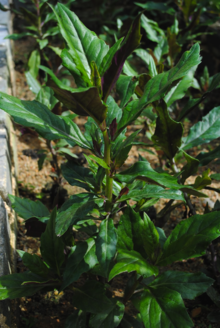Gynura bicolor
| Gynura bicolor | |
|---|---|

| |
| Hongfeng cai 紅鳳菜 plant | |
| Scientific classification | |
| Kingdom: | |
| (unranked): | |
| (unranked): | |
| (unranked): | |
| Order: | |
| Family: | |
| Tribe: | |
| Genus: | |
| Species: | G. bicolor
|
| Binomial name | |
| Gynura bicolor | |
| Synonyms[1] | |
| |
Gynura bicolor, hongfeng cai 紅鳳菜, okinawan spinach or edible gynura, is a member of the chrysanthemum family (Asteraceae). It is native to China, Thailand, and Myanmar but grown in many other places as a vegetable and as a medicinal herb.[2]
There are two kinds: one that is green on both sides, and another with leaves that are green on the top and purple underneath. Both kinds are considered medicinal vegetables. Gynura bicolor is a perennial and therefore found for sale throughout the year; however, winter and spring is the best time.[citation needed]
Uses
Gynura bicolor is rich in iron and potassium, calcium, vitamin A, etc. According to Chinese food grouping, Gynura bicolor is a 'cool' food,[3] so the leaves are stir-fried with sesame oil and ginger (both 'hotter' foods) to achieve a balance. The stems and roots of the plant can also be made into tea by boiling with water. Choose leaves with few bruises and without black stains.[citation needed] In Japan, Gynura bicolor is eaten as local vegetable in Ishikawa, Kumamoto and Okinawa and so on, blanched lightly and served with ponzu, as an ingredient of miso soup, or tempura.[citation needed]
Propagation
Taking cuttings is very easy.[4]
Footnotes
- ^ The Plant List, Gynura bicolor (Roxb. ex Willd.) DC.
- ^ Flora of China, Gynura bicolor (Roxburgh ex Willdenow) Candolle, 1838. 红凤菜 hong feng cai
- ^ "Chinese Kitchen" (PDF). communitycenter.org.tw. Retrieved 2012-12-16.
- ^ "Taking cuttings". GreenTaiwan. Retrieved 2012-12-16.
External links
